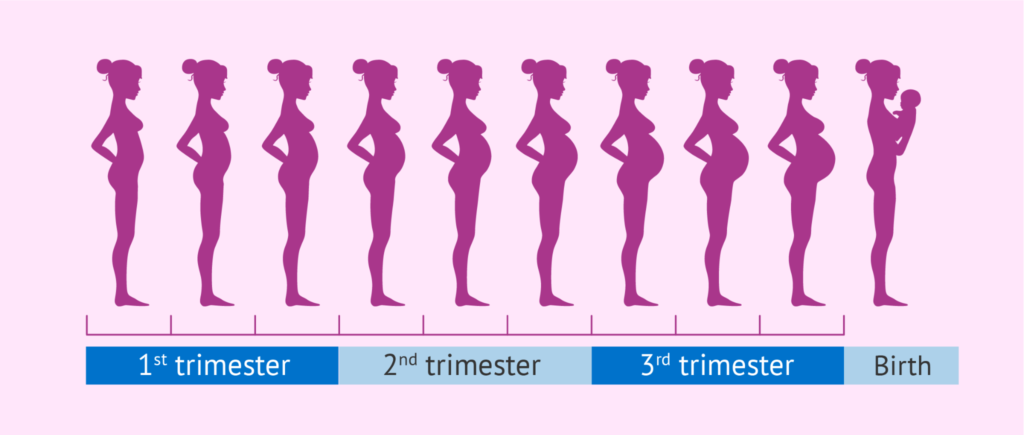If this is your first baby then you’ve probably just been exposed to a whole new world of terminology, a lot of which you never hear outside of pregnancy and there’s a strong likelihood some of the language and terms have left you scratching your head. We’ve got you covered. This article will go through terms like trimesters and other technical words healthcare loves using to describe the wonderful world of pregnant mums.
A full-term pregnancy lasts around 37 – 40 weeks from the first day of your last period. These 40 weeks are divided into three stages called TRIMESTERS. Each trimester comes with different signs and body development for both the mother and the baby.
Your first trimester (0-13 Weeks)
Your first stage of pregnancy is called the first trimester. During this period, your baby’s body structure and organs develop. A baby grows rapidly from an embryo ( 3 Weeks after fertilization) to a fetus – in the eight week of pregnancy. Generally, it’s called an embryo from conception until the eighth week of development. After the eighth week, it’s called a fetus until it’s born. The fetus begins developing their brain, spinal cord, and organs. The baby’s heart will also begin to beat at around the 7/8 week mark.
How does the first trimester affect you? Your stomach isn’t yet protruding at this stage, as the baby is just forming but certain physical changes occur in your body. Not everyone will experience all of these symptoms and some women won’t experience any. Typical in the first trimester is nausea, fatigue, breast tenderness and frequent urination.
it’s estimated that about 1 in 10 pregnancies end in miscarriage, and that about 85 percent of these occur in the first trimester.

Second Trimester (14 to 26 weeks)
This is the longest of the three trimesters and is often thought of as the best part of the pregnancy experience. You tummy is still growing, is not uncomfortable yet and all the early signs of pregnancy usually resolve, so no more nausea You’re likely to have increased energy and sleep better as your body’s systems are in overdrive, providing that ‘glow’ most mothers experience. However, your tummy expands as the baby grows and you’ll need a new wardrobe for this trimester. This period is also associated with swollen face and fingers, as well as darker skin.
Your baby will start to develop facial features during this trimester. Bone marrow is making blood cells and the lungs have formed, but don’t work yet. You may also start to feel movement as the baby begins flexing little muscles, flipping and turning in the uterus. Expect movement, kicking and punching as the small person begins flexing. This is known as “quickening” and happens somewhere between 16-20 weeks.
It is also during this trimester that the sex of the baby is determined, through a scan (an ultrasound that checks physical development) around 20 weeks. You can read more on the different ultrasounds you will undergo here
After 23 weeks, your baby has achieved a state we refer to as “viable.” This means that it can survive living outside of your womb, obviously with the use of life support as it’s lungs are still not adequately developed yet. This is the time some women experience premature birth, which is far from desirable and something doctors strive to prevent if they can. Babies born this early face serious medical challenges and risks.
Third Trimester (27-40 Weeks)
Well done, you and your baby have reached the final phase of your pregnancy. Each week of this final stage of development helps your baby prepare for birth. Throughout your third trimester, the baby gains weight quickly, adding body fat that will help after birth. This makes your belly grow exponentially, making it much larger than it was in the second trimester.
Some of the physical symptoms you may experience during this period include shortness of breath, hemorrhoids, urinary incontinence, varicose veins, and sleeping problems. Expect to be visiting the bathroom frequently as you bladder is placed under constant pressure from your baby’s growth spurt.
Baby’s brain also develops rapidly at this time, he or she can see and hear already, and most internal systems are well developed.
In this final month, you could go into labor at any time as babies frequently completely ignore due dates. Be prepared for this nd also be aware that rather than being born early, some babies tend to stick around for a week or two after your expected delivery date. If you are very uncomfortable at this point you can discuss inducing labor with your doctor.
You’ll notice that baby typically moves less in the last month as they’ve literally run out of space. space. Usually, as the end of your third semester approaches, your baby will have inverted itself, head down, bum in the air, to prepare for an exit, or entrance, dependent on your perspective. Contractions, when they start, are baby’s way of chemically prompting your muscles to induce birth.
Now that you know what to expect over the next nine months, why not learn more about some of the terms your doctor may use during your visit and what they mean. This article, called Understanding MedSpeak in Pregnancy will help explain most of the terms you’ll hear.